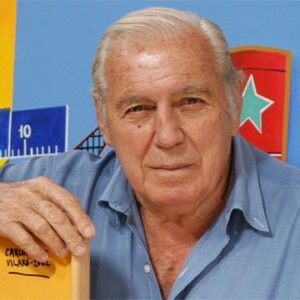Carlos Paez Vilaro was an artist with several facets. He was an artist who worked as a painter, potter, sculptor, muralist, writer, composer, and builder. His artistic interests carried him to Argentina, Brazil, Africa, and Europe, and his creations reflected his cultural travels. As an abstract painter, sculptor, muralist, and architect, he experimented with numerous mediums to create his extraordinary work. He was a white man who was enthralled by the black Uruguayan tradition. He rose to prominence early in his career, and his artistic vision was limitless, manifesting itself through music and filmmaking. He was commissioned by governments, commercial companies, and people to create innovative murals and artistic expressions as a successful muralist and sculptor. Many of his murals, musical compositions, and celebrations of Afro-Uruguayan ‘Candombe’ music and dance were inspired by his interest in Afro-Uruguayan culture. He lived and worked as an artist, which is reflected in the architecture he created, which is often reminiscent of Anton Gaudi’s and Salvador Dali’s styles. Vilaro was a passionate, dedicated, and tireless artist who worked almost until the day he died at a ripe old age.
Childhood and Adolescence
Carlos Paez Vilaro was born on November 1, 1923, in Montevideo, Uruguay, and grew up in a poor family. At a young age, he began his artistic career by drawing.
In 1939, he travelled to Argentina to work as a printing apprentice. He was deeply moved by the contrast between the mundaneness of factory life and the dynamism and excitement of Buenos Aires’ Tango districts, and he used these perceptions to produce his early works.
He returned to Uruguay around ten years later, in the 1940s, and began to explore the vivid, bold hues of Afro-Uruguayan arts and culture.
Career of Carlos Páez Vilaró
He spent the years in Buenos Aires from 1939 until the late 1940s exploring art through drawings and absorbing cultural experiences. He subsequently went to Uruguay, where he immersed himself in Candombe dance and music while living in Mediomundo and intrigued by Uruguay’s black roots.
Carlos Paez Vilaro joined the ‘Grupo de los 8′ artists’ movement in 1958, which aimed to introduce new painting techniques. He bought the property in Punta Ballena, near the sea, that would eventually become the famed ‘Casapueblo,’ which he designed and built in his own distinct vision.
He traveled extensively throughout Brazil, Africa, and Europe, but he always returned to Uruguay and his love of Afro-Uruguayan themes in art and music. Markets, funerals, festivals, sandpipers, snatches of everyday life, and unusual incidents all found their way onto his canvas, and his vibrantly colored murals could be found as far away as Washington, D.C.
Major Projects of Carlos Páez Vilaró
‘Casapueblo,’ unquestionably one of Vilaro’s crowning achievements, was created gradually over time, expanding in size, form, and majesty. This strange and fascinating building, a flash of dazzling white erected by the deep azure sea, was his house and workplace, and eventually a hotel. This was his “living sculpture,” which was inspired by the nests of the local ‘hornero’ birds. Tourists are now drawn to it because of its captivating form and organic art.
He constructed the San Isidro Chapel in Buenos Aires, which incorporates natural elements into the construction. He built a clean white chapel that reflected the tranquil surroundings and vibrancy of nature, drawing on all of his experiences and views.
In 1959, he created the 155-meter-long and 2-meter-high ‘Roots of Peace’ mural in the Pan Union American Building’s tunnel, which housed the ‘Organization of American States’ in Washington, DC.
Achievements & Awards
Carlos Paez Vilaro’s murals, architecture, paintings, pottery, and drums may be seen all over the world, from Uruguay and Latin America to North America, Africa, and the Polynesian Islands.
He made a name for himself as a director and screenwriter with his documentary ‘Batouk,’ which was based on African dance and premiered at the Cannes Film Festival in 1967. His ardour and compositions for African ‘Candombe’ were important in giving respect and affection to a socially inappropriate dancing genre.
Personal History and Legacy
Carlos Paez Vilaro was a passionate person in life, art, and love. His first marriage, to Madelon Rodriguez Gomez, in 1955, lasted six years and brought him three children. His son “Carlitos” Paez Rodriguez was a member of the collegiate rugby squad and was nearly murdered in a plane crash that was carrying the team. He was found alive and rescued after being missing for 72 days.
In 1976, he met Annette Deussen, a married lady, and became her paramour, which led to issues. In 1984, she gave birth to his child and eventually divorced her husband in 1986.
He died on February 24, 2014, at the age of 90, at Casapueblo, his cherished and colorful home in Punta Ballena, Uruguay.
Estimated Net Worth
Carlos is a well-known painter who is among the wealthiest. Carlos Paez Vilaro’s net worth is estimated to be at $1.5 million, according to Wikipedia, Forbes, and Business Insider.
Trivia
Vilaro’s imagination led to several gadget designs to endow architecture with dramatic aspects, such as the one he developed in his ‘Casapueblo’ to celebrate each sunset. Every evening, a scripted recording of his voice reading an Ode to the Sun to the tune of a Spanish guitar plays, timed to the exact moment the sun sets.
The rescue of his kid, among the 16 survivors of the plane crash in the Andes known as ‘The Miracle of the Andes,’ is shown in the 1993 film ‘Alive.’


